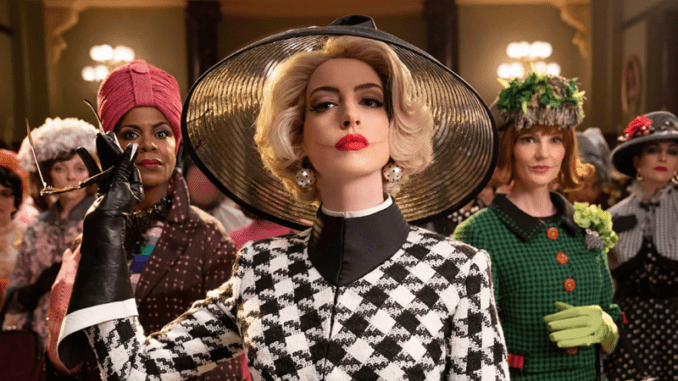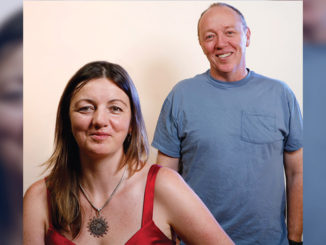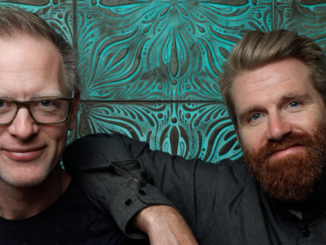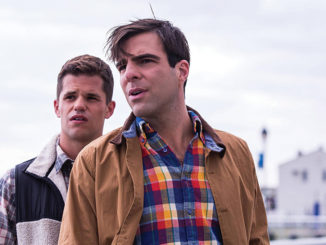
By Ryan Chan
On October 26th, 1985, I saw “Back to the Future” in a movie theater for probably the fourth time. It was my cousin Jane’s birthday, and the date was also memorable because it was on that day in 1985 that “Back to the Future” takes place. I felt like if I had been at Twin Pines Mall early that morning, I might have witnessed a DeLorean disappear in a flash, leaving behind a pair of fire trails.
I loved the characters, the twists and turns of the plot, the humor, the action, and the adventure. I had loved director Robert Zemeckis’ previous movie, “Romancing the Stone,” but “Back to the Future” made me a Zemeckis fan for life. “Back to the Future” bounced around between the different theaters in my town for an entire year, and I saw it eight times.
Now, 35 years later, I’m proud to say that I had the honor of editing Robert Zemeckis’ latest film, “Roald Dahl’s The Witches,” alongside Zemeckis’ longtime editor Jeremiah O’Driscoll, who has edited all of Zemeckis’ films since 2004. Being able to watch Jeremiah and Zemeckis edit movies for the better part of the last decade and a half taught me just about everything I know about film editing.

“The Witches” is based on Roald Dahl’s 1983 book of the same name, which was also made into a film directed by Nicholas Roeg in 1990. This retelling changes the setting to 1967 Alabama and tells the tale of a young boy (Jahzir Kadeem Bruno) who, along with his Grandma (Octavia Spencer), encounters a coven of witches, led by the diabolical Grand High Witch (Anne Hathaway).
Editing “The Witches” began in March 2019 at Warner Bros. Studios in Leavesden, about 20 miles north of London. I was the first member of the editorial team to land in the UK, where I was joined by assistant editor Robert Sealey and editorial trainee Anna Koronkiewicz. With their help, we got the cutting rooms set up and I started putting Previs and storyboards together on a few key sequences.
Our rooms were set up next to a bullpen where Zemeckis was able to shoot Previs footage with a handheld virtual camera. A team of artists was based in the bullpen, prepping scenes, cleaning up shots, and animating Previs for upcoming scenes while Zemeckis was shooting. As an editor, having direct access to the Previs and VFX teams made it incredibly convenient to request additional shots for the cut.
A week before shooting was scheduled to start, we were joined by Jeremiah O’Driscoll and first assistant editor Jesse Goldsmith. Jeremiah started cutting new Previs scenes that had just been approved by the director and I continued with the scenes I was already working on.
Principal photography started on April 26th. Jeremiah started with the first scenes that were shot and we leapfrogged scenes from there.
One of the longest scenes in the movie, Scene 44, took 11 days to shoot, spread over the course of an entire month of the shoot. In it, the Grand High Witch reveals the details of her evil plot to her coven of witches. Since I cut the Previs for the scene, I was also given the task of cutting the scene for the movie.
To give structure to the scene, I started my sequence with a duplicate of the approved Previs cut. As each beat of the scene was shot, I replaced that section with the hot-off-the-press live action footage. This let both the director and I know what was missing as we reviewed the scene.
When I show cuts to the director, I like to present them with a full temp music and sound effects pass. This was a challenge with a scene whose first cut was nearly 25 minutes long. Unfortunately, I totally misjudged the tone of the music on my first pass, and Zemeckis let me know that it wasn’t working. I lifted every cue in the 25-minute scene and replaced it all before the next time I showed it. Luckily, the second attempt passed the test and we had a framework for the scene that would be recut through all of production and post.
The rest of the shoot went smoothly. Jeremiah and I continued trading off scenes as they were shot, and we were able to show the entire movie to Zemeckis the morning after the final day of shooting. We were missing a handful of scenes that would be completely CG or would be shot by a splinter unit, but we were able to get the director’s first impression of the bulk of the movie while the sets were still being broken down.
We continued editing in London for most of the summer and had a polished version of every scene by the time we headed back to the States in August. When we started back up in California, we added assistant editor Christi Leftwich, VFX editors Alison Learned-Wolf and Derrick Mitchell, and post-production assistant Simone Staff. We quickly settled into the cutting rooms and were soon joined by a team of VFX production staff and artists.
The most challenging part about editing the movie continued to be Scene 44. It’s the most iconic scene in the book, and it’s where we as the audience finally get to see what the witches look like without their signature gloves, shoes and wigs. But the amount of exposition required a scene that was at least 10 minutes long and, as Zemeckis reminded us repeatedly, “No one would ever write a scene like that in a modern movie.”
Months of trimming and adding back lines of dialogue, removing and restoring entire sections from the script, dozens of music edits (the final temp music pass was put together by music editor Katrina Schiller), and hundreds of Postvis iterations resulted in the scene that ended up in the final movie. It was a tremendous amount of work, but in the end, I’m extremely proud of where it ended up.
Outside of watching various versions of the movie with the core team in our office, we screened the movie for various studio executives and for two small recruited audiences on the Warner Bros. lot. Then, as we prepared for our first real audience preview, COVID-19 hit.
Starting in early February, we had been keeping an eye on the news about the mysterious new virus that was making its way around the globe. And one day in early March, we were sent home as a safety precaution. Later that week, Los Angeles Mayor Eric Garcetti ordered all non-essential businesses to shut down.
The night the safer-at-home order was given, each member of the editorial crew left the comfort of their home to meet at the office, where techs from Pivotal Post had set up our Avids to work remotely. We were each given a PC, a monitor, a keyboard, a mouse, and a pair of headphones and were sent home for what would be the last time on the show.
From that day in March until we locked picture in July, we worked from home using HP’s Remote Graphics Software. We would each log into our home PC, use a VPN to connect to our work machine, then screen share with that machine’s desktop using RGS.
From an editing perspective, aside from the occasional crash, the remote setup worked great. There was hardly any lag and everything worked as expected. As a longtime Mac user, the only thing that took time to get used to was the PC keyboard shortcuts. I accidentally pressed the Windows button so many times, I felt like Bill Gates was going to call me to make sure everything was alright.
Part of the reason the work-from-home setup worked so well for us is that we had just gotten through the phase where scenes are being reworked, shuffled around, and lifted. The VFX editors had hundreds of shots to cut in every week, many of which required some finessing of the cut, but nothing major that required lengthy cutting sessions with the director. Most of the next four months was spent making small adjustments to the cut and in semi-weekly VFX reviews.
Though I prefer working in the office and being able to chat with team members face-to-face, the biggest upside of participating in a VFX review from a virtual workstation was the ability to get work done while the review was taking place.
During a normal in-person review, the director would give cutting notes to editorial or shot notes to the VFX team, then Jeremiah and I would head to our offices to make the changes after the meeting. Instead, because I was virtually sitting at my Avid, while Zemeckis was reviewing Jeremiah’s shots, I had time to make the necessary changes or a temp comp for VFX and show them at the tail end of the review. This enabled the director to review many shots twice in the span of one review, which led to additional finals.
After settling into the VFX review schedule for four months, the number of outstanding shots began to dwindle and it came time to venture back out into the real world to finish the movie. In a six-week span, we scored the movie, completed a temp dub and the final mix, finished the DI and approved the final DCP. None of this would have been out of the ordinary… except we were doing it all in the age of COVID.
Up until the week leading up to our first scoring session at Abbey Road, we weren’t sure it was even going to happen. How do you assemble an orchestra in a room when you’re practicing social distancing? The solution for each of the facilities we used was social distancing, significantly-reduced room capacity, and lots of hand sanitizer.
Twenty-five musicians were allowed in Abbey Road’s Studio Two at one time, which can usually hold a 55-piece orchestra. And instead of being in the control room at the studio, everyone from the director and the Composer to the producers and the editors watched using Clearview Flex, which enabled us to watch the musicians performing the score in an encrypted real-time stream from thousands of miles away.
For the temp dub, which was on Stage X on the Warner Bros. lot, 5 people were allowed on the stage at one time, which included mixers Tim LeBlanc and Michael Keller, Mix Tech Daniel Nakamura, Jeremiah, and myself.
For the Final Mix, five people were allowed at one time on Stage 10 on the Warner Bros. lot, which included Skywalker Sound’s Randy Thom (Re-Recording Mixer), Kevin O’Connell (Re-Recording Mixer), Bjorn Schroeder (Dialogue Editor), and Leff Lefferts (FX Editor). Liquid Music’s Alice Wood (Music Editor), Mix Tech Mark Purcell, Jeremiah, and I would rotate in and out in the 5th spot. Zemeckis, Composer Alan Silvestri, and the producers again used Clearview Flex to monitor the mix from home.
And for the DI, our session happened to commence just as Technicolor expanded their guidelines to allow 4 people instead of 3 into their DI suites. On the days that Jeremiah and I attended, the group included colorist Maxine Gervais and director of photography Don Burgess.
Somehow, despite all of the restrictions and hoops we had to jump through, the movie was completed and everyone from the filmmakers to the studio seem to be thrilled with the final product.
The experience of making “The Witches” was everything I had hoped for and more. From the excitement of seeing new dailies to the anxiety of showing a cut for the first time to the pride of making the final tweaks to a scene, it was a rollercoaster ride that I didn’t want to end. I love the characters, the twists and turns of the plot, the humor, the action, and the adventure.
When we left the editorial offices to start working from home in March, I assumed we would return at some point, and that the movie would hit theaters on October 9th as planned. But as the summer dragged on and the number of COVID-19 cases in California continued to rise, it became clear that movie theaters would be closed well beyond our scheduled release date. The crew wrapped the show in late August, expecting to have to wait until 2021 to share the movie with family and friends. To our surprise, a few weeks later, it was announced that “The Witches” would premiere on October 22nd on HBO Max.
It’s bittersweet seeing the movie released into the world, knowing that it might never see a wide release in theatres. But in the end, where you see it doesn’t matter as much as who you see it with. There’s nothing like getting lost in a movie with your loved ones and forgetting about the real world for 90 minutes, and I think “The Witches” fits the bill perfectly.
And if I had a time machine to go back 35 years and tell my little kid self what it was like to edit a movie for Robert Zemeckis? I’d tell him it was worth the wait.
Ryan Chan, a picture editor, has been a member of the Editors Guild since 2000.





